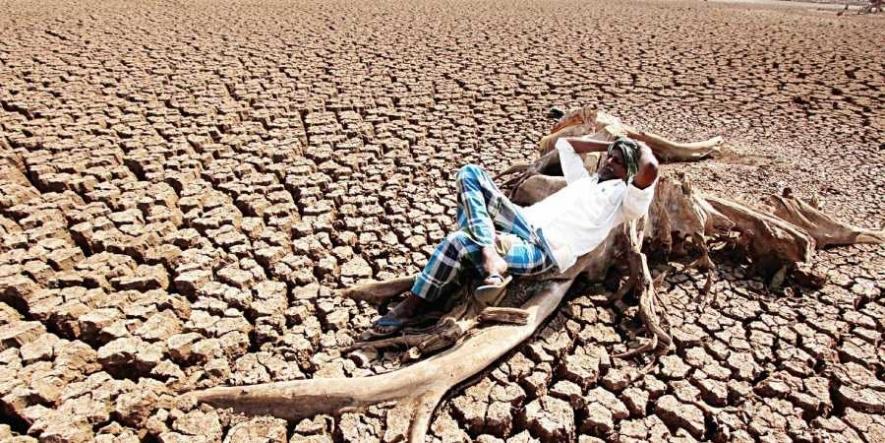#DroughtDistress: Karnataka Runs Dry for Fourth Consecutive Year

The Karnataka government had declared 156 out of 176 taluks as drought-hit in December 2018. Of these, 95 taluks are ‘severely hit’ and 61 are ‘moderately hit.’ The deficit northeast and southwest monsoons in the state is the main reason for the drought.
This is the fourth consecutive drought in the state, in 2017-2018, in the Kharif season, 100 taluks were declared drought-hit and in the Rabi season 107 taluks were declared ‘severely hit’ and 49 as ‘moderately hit.’ In 2016-2017, as many as 164 taluks were declared drought-hit. In fact, the data of Karnataka State Natural Disaster Monitoring Cell (KSNDMC) show that except for the coastal region, none of the other regions received enough rainfall between 2001-2015 and it is only these areas that were not drought affected.
As reported earlier in Newsclick, the state is facing an acute shortage of drinking water. The state government has so far declared 3,122 regions to be highly affected by drinking water scarcity and this number is only increasing, as reported by News18. According to the Department of Rural Development and Panchayat Raj, off the 176 taluks, 138 have groundwater at a low level. The worst of these are Bagepalli, Chikkaballapura, Sidlaghatta, Bangarpet and Kolar. As a report in Deccan Herald notes, this persisting condition in the state is due to the lack of an approach to water management.
Also Read: Drinking Water Crisis in Karnataka Persists, Forces Schools in Udupi to Stall Mid-Day Meal Scheme
R S Deshpande, former Director of the Institute for Social and Economic Change (ISEC), Bangalore, observes, “the agricultural economy of Karnataka is a typical combination of vast drought-prone areas co-existing with regions having assured irrigation.The state’s agriculture sector has been distinctive for its hugely varying phases of growth and stagnation. the state has a disproportionate share of drought-prone areas in the country. During the mid-1980s the problem of stagnation of the agriculture sector was severe and attracted the attention of policy makers.” To the policy makers now, the agriculture sector is merely a vote bank. This can be seen in the naive approaches to deal with a crisis situation which would merely appease a farmer for short term.
The current Congress-Janata Dal (Secular) [JD(S)] government, for example, has been all about the farm loan waivers. In its election manifesto, the JD(S) following the examples of other parties elsewhere, had stated that the government would waive all agriculture loans in one go. This would include crop loans, horticulture loans, and medium-term loans availed by the Karnataka farmers. However, in its maiden budget, the coalition government, announced a loan waiver scheme proposing to waive loans in phases and not on a one-time basis. The budget, as expected, was not welcomed by farmers in the state. Speaking to Newsclick then, Chukki Nanjundaswamy of the Karnataka Rajya Raitha Sangha (KRRS), had observed, “loan waiver is a political agenda.”
Measures to Deal With the Drought
Travelling across the state during the general election campaign, Newsclick had asked farmers in four districts, out of which two are declared drought hit, if they had got there loans waived. The response was mixed: while some claimed to have got their loans waived, some complained about the bureaucratic work involved while some others said they were not aware of any development with respect to their loans.
Also Read: Are Farmers of Karnataka Being Deceived by False Promises of the Government?
As argued earlier, waiving loans is not a long-term solution.Since the state had already seen three consecutive years of drought, one wonders if the government was ready to handle the drought situation? The current government apart from concentrating on loans waivers, has been involved in tackling the effects of drought, such as elevation of poverty due to crop loses and is also providing relief loans to farmers.
What is, however, required in the state is some long term measure, as pointed out by some social activists.
Scheduled commercial banks and small financial banks were asked in November 2018, by the government, under the Reserve Bank of India (Relief Measures by banks in areas affected by Natural Calamities) Direction 2017, to provide relief measures to the affected regions. “This was achieved by rescheduling exit loans and sanctioning fresh loans based on the requirement of borrowers who have suffered crop losses of 33 per cent or more in the area they are cultivating,” reported the New Indian Express. The government has also sanctioned one crore rupees per taluka to the rural development and panchayati raj ministry for drinking water- related work.
Also Read: Drought in Karnataka: A Human-made Disaster
According to a report in Livemint, the government has also increased the number of man-days in drought-affected talukas from 100 to 150, under the Mahatma Gandhi National Rural Employment Guarantee Scheme to generate employment and provide an alternative source of income for the agricultural community. The government said that it aims to increase the total man-days from 10 million per month currently to 100 million by the end of March. While the state government is working towards handling the drought situation, it is not getting enough assistance from the Centre. The state has been allotted just Rs 943 crore. However, the glaring agrarian crisis in the country in general is a problem staring at the newly formed Narendra Modi-led National Democratic Alliance government.
With predictions being made about the possibility of yet another deficit monsoon, it is reported that the state government is undertaking cloud seeding. “The State cabinet approved a budget of ₹91 crore for cloud seeding for two years. The project, which involves two aircraft spraying chemicals at moisture-laden clouds to induce rainfall, is expected to start by June-end and would continue for three months through the monsoons,” reported The Hindu.
Also Read: Elections 2019: Are We Merely a Vote Bank? Farmers of North Karnataka Ask
Get the latest reports & analysis with people's perspective on Protests, movements & deep analytical videos, discussions of the current affairs in your Telegram app. Subscribe to NewsClick's Telegram channel & get Real-Time updates on stories, as they get published on our website.























